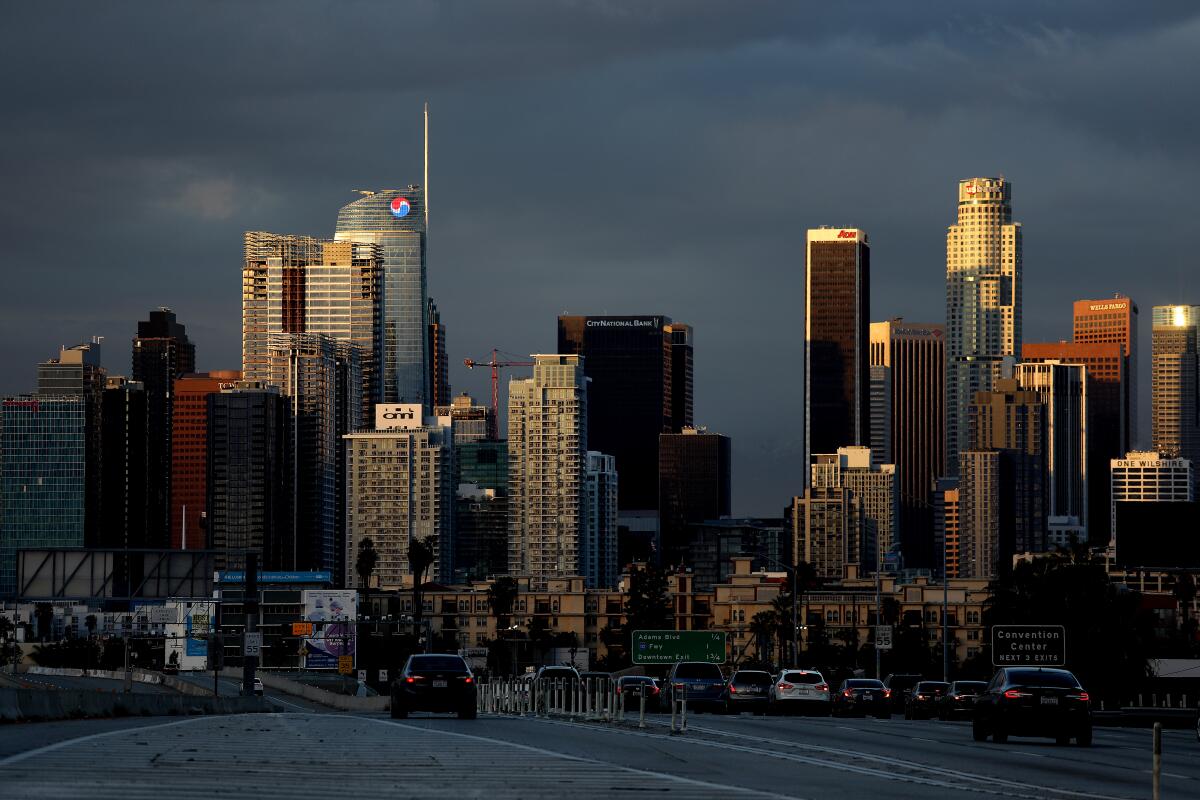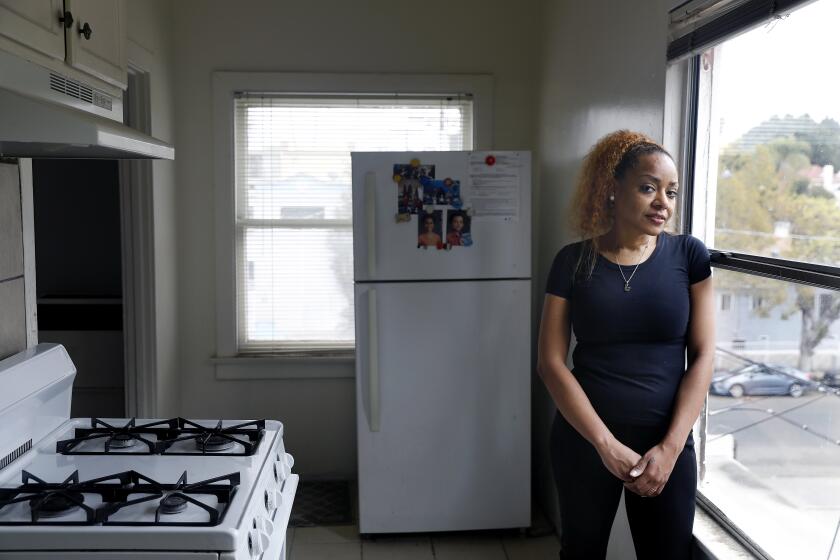These California cities are booming even as L.A., San Francisco lose population

Brian Harrington was looking for a bigger house in 2021. He and his wife were expecting a baby and were able to work from home.
They settled on the Riverside County community of Menifee, about 54 miles from their Anaheim home.
Harrington, who works as a public relations consultant for Bitcoin startups, searched online for “homes in low 600s Southern California” and was directed to the fast-growing corridor of communities along Interstates 15 and 215.
The couple ended up buying a home in Menifee’s Audie Murphy Ranch community. “Love the house, love the neighborhood,” Harrington said, noting that the area “feels like Orange County.”
As far as downsides go, shopping is limited to “only box stores and big chain restaurants,” he said. “I haven’t found my hole-in-the-wall dive bar that I love yet.”
Big coastal cities in California, led by San Francisco and Los Angeles, have seen declines in population in recent years. Some residents have left for cheaper housing in other states. But during the same period, some California suburbs like Menifee have seen significant population booms.
In his feud with California, Florida Gov. Ron DeSantis claims the Golden State is losing residents because of its leftist ways. Indications suggest otherwise.
From 2019 through 2022, 1.02 million more people moved out of homes and businesses in California than into them, a Times analysis of U.S. Postal Service data shows.
The data show the five ZIP Codes with the most net move-ins were all suburbs or exurbs around Sacramento and Southern California, including cities such as Irvine, Menifee and Walnut.
These fast-growing spots are generally suburbs with new housing coming on line. Some, like Irvine, are high-priced and close to job centers. Others, like Menifee, are farther out from urban cores but offer bigger homes and more outdoor space for the money. As the practice of remote work rose during the pandemic, far-flung communities made more sense for some.
While Harrington stayed in California, many others have left the state entirely. The Postal Service’s change-of-address data support the theory that California’s shrinking population is largely the result of net migration out of the state, experts say.
No data set is perfect, and Paul Ong, director of the Center for Neighborhood Knowledge at UCLA, added a note of caution: “There is a bias to reporting out moves in many situations,” he said, referring to change of address requests filed with the post office.
The USPS data include mostly permanent and some temporary moves for individuals, families and businesses.
Of the more than 1,700 ZIP codes reviewed, 58% showed more move-outs than move-ins during the four-year span.
USPS processed about 36 million address changes in 2021 nationwide. Requests can be submitted online or using a paper form at a post office. When scaled for population, net move-out numbers in California are middle of the pack among states nationally.
One of those Californians planning to leave the state is Kevin Britton, who has steady work in Southern California and loves to ride his motorcycle to the sun-splashed cities of Malibu and Santa Monica. But he said he’s fed up with the crime and the high cost of housing in the area.
So, the 34-year-old photographer and his wife are packing up their Sylmar townhouse and moving to Las Vegas this spring.
“The pay scale doesn’t pay enough to justify the cost of living out here,” he said, describing housing costs in California as “otherworldly.”
Britton’s move reflects an ongoing demographic trend in the Golden State: Most of those residents moving out are leaving big cities like Los Angeles and San Francisco.
Over the last few years, a new pattern in California suggests that “the middle of the cities emptied out,” and “people moved to the outer ring of the metro,” said Dowell Myers, a professor of policy, planning and demography at USC.
Indeed, The Times’ analysis shows that of the five ZIP codes with the most net move-outs, three were in San Francisco and one was in Los Angeles.
The Northern California town of Paradise saw the second-most net move-outs following the devastating Camp Fire in late 2018.

Subscribers get exclusive access to this story
We’re offering L.A. Times subscribers special access to our best journalism. Thank you for your support.
Explore more Subscriber Exclusive content.
In the other direction, Menifee and other small cities continue to grow.
Armando Villa, the Menifee city manager, said he is working to transform the area “from a rural community and a lot of vacant land to a really prosperous city.”
Menifee became a city in 2008, he said, making it the third-most recently incorporated city in California.
Since then, the population has skyrocketed, jumping from 85,000 in 2016 to an estimated 116,000 now, Villa said.
The city has been intentional about growing, he said. “We weren’t surprised by it.”
“A lot of new homes are being built,” he said, even as interest rate hikes are slowing home sales.
City data show that over 4,500 housing units were built from 2019 to 2022 in Menifee, with virtually all of them — 97% — being single-family homes.
Many of the new residents come from Los Angeles, Orange and San Diego counties, according to Villa. “Housing shortages are making people drive this way to buy an affordable home,” he said.
Not everyone is on board with the rapid growth. In the “Menifee 411” Facebook group, where some 22,000 members post about the community, a recent image of a proposed development drew ire from locals.
“Just stop. You’re taking away all the beauty of this place. It’s called hills and open land,” the top comment read. Another: “We are running out of water and the power grid can’t handle what we have now. Please stop building.”
While causation is complicated across large groups of people, experts pointed to key factors influencing migration: housing prices and the COVID-19 pandemic.
“The housing market was already really a problem” in 2019, when the data show more than 200,000 excess move-outs relative to move-ins before the pandemic, said Myers.
“Renters can move easy — owners can’t,” he said, noting that migration numbers are biased toward renters, who are typically younger and less wealthy than homeowners.
The moving trend was exacerbated by the pandemic.
The pandemic “synchronized everybody’s behavior,” causing home prices to jump “all of a sudden, tremendously” atop the preexisting problems with the housing market, Myers said.
Irvine is another city seeking to build housing to entice prospective homeowners from more expensive nearby cities.
Mayor Farrah Khan was not surprised that an Irvine ZIP Code shows the second-most net move-ins of any in California. In the area near the city’s Great Park, some 10,000 homes have been proposed, she said, and builders have completed “6,000 to 7,000 so far.”
Noting that Irvine’s population nearly doubles during business hours, Khan said that “we want to see more folks that live in Irvine [and] work in Irvine.”
California lost more people than any state besides New York between April 2020 and July 2022, data show. Texas gained nearly 900,000 people in the same period.
People moving in are coming from all over, she said, including those who come from “within Irvine, from Northern California, New York,” and immigrants from China and South Korea.
California has had net domestic out-migration since 1990, according to Richard Green, director of the USC Lusk Center for Real Estate. “Overwhelmingly the out-migrants are low-income people,” he said.
For two decades, “there was enough foreign migration to more than overwhelm the domestic out-migration” and keep California growing, Green said. Mexico and China accounted for large numbers of immigrants.
Recently, though, with cost-of-living increases and immigration curtailed by Trump administration policies and the pandemic, net out-migration has increased while immigration has decreased, contributing to the state’s dropping population.
Britton, who grew up in the Miami metropolitan area, said he’s “no stranger to high cost of living.”
As a photographer, Britton’s main subjects are quintessentially Californian: high-end cars and porn stars.
One woman’s story reveals how challenging L.A. County’s court system can be to navigate as eviction filings increase.
“I have so many clients out here,” he said of Los Angeles, but “there’s no reason to stay when it’s cheaper to travel here” and live elsewhere.
He also has had issues with crime in Los Angeles: His truck was vandalized, his trailer burglarized and then set aflame. Drivers exhibiting signs of road rage sometimes “follow us home and try to start something,” Britton said.
In searching for somewhere else to go, Britton and his wife researched Texas, Colorado, Seattle and Las Vegas. Their choice was easy: They spotted a 3,200-square-foot house in Vegas that rents for half what the couple pays for their 1,300-square-foot townhouse in Sylmar.
After the moves, Britton said he’ll miss seeing classic cars on the streets of Los Angeles and the city’s restaurant scene.
“Everybody wants to live here, but it’s too expensive,” he said.
Watch L.A. Times Today at 7 p.m. on Spectrum News 1 on Channel 1 or live stream on the Spectrum News App. Palos Verdes Peninsula and Orange County viewers can watch on Cox Systems on channel 99.
More to Read
Start your day right
Sign up for Essential California for news, features and recommendations from the L.A. Times and beyond in your inbox six days a week.
You may occasionally receive promotional content from the Los Angeles Times.











